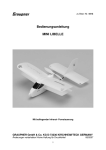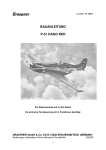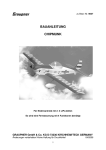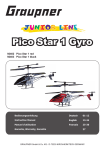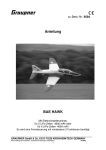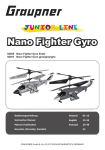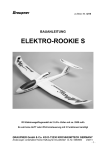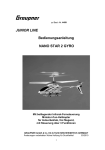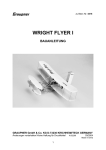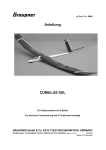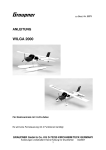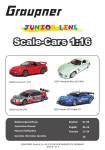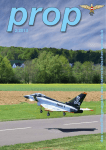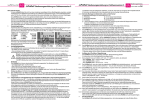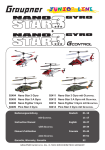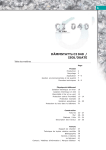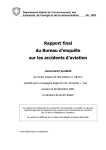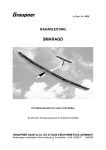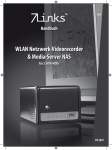Download 4412 Micro FILOU DE_EN_FR - MHM
Transcript
zu Best.-Nr. 4412 Bedienungsanleitung MICRO FILOU Mit beiliegender Infrarot- Fernsteuerung GRAUPNER GmbH & Co. KG D-73230 KIRCHHEIM/TECK GERMANY Änderungen vorbehalten! Keine Haftung für Druckfehler! 1 01/2008 Vorwort Das GRAUPNER RC-MODELL MICRO FILOU ist ein Indoorflugmodell welches auch bei Windstille im Freien geflogen werden kann. Das Modell ist fertig gebaut, Flugakku befindet sich im Rumpf. Es müssen nur Batterien in den Sender eingelegt werden, Flugakku laden und der Flugspass kann los gehen. Beim Modell MICRO FILOU handelt es sich um ein kleines Elektro-RCMotorflugmodell für Jugendliche über 14 Jahren, bei Jugendlichen unter 14 Jahren muss der Betrieb des Modells von einem Erwachsenen beaufsichtigt werden. Achtung: Dieses Modell ist kein Spielzeug! Sollten Sie mit solch motorisiertem Modell keine Erfahrung haben, wenden Sie sich bitte an erfahrene Modellflieger, die Sie unterstützen können. Es könnte zu Verletzungen kommen, wenn das Modell ohne Vorkenntnisse in Betrieb genommen wird. Denken Sie an die Sicherheit und Ihre Gesundheit. Wichtige Sicherheitshinweise Sie haben ein Modell mit Infrarot-Fernsteuerung erworben. Die Einhaltung der Betriebsanleitung im Zusammenhang mit dem Modell sowie die Installation, der Betrieb, die Verwendung und Wartung der mit dem Modell zusammenhängenden Komponenten können von GRAUPNER nicht überwacht werden. Daher übernimmt GRAUPNER keinerlei Haftung für Verluste, Schäden oder Kosten, die sich aus dem fehlerhaften Betrieb, aus fehlerhaftem Verhalten bzw. in irgendeiner Weise mit dem Vorgenannten zusammenhängend ergeben. Soweit vom Gesetzgeber nicht zwingend vorgeschrieben, ist die Verpflichtung der Firma GRAUPNER zur Leistung von Schadensersatz, aus welchem Grund auch immer ausgeschlossen (inkl. Personenschäden, Tod, Beschädigung von Gebäuden sowie auch Schäden durch Umsatz- oder Geschäftsverlust, durch Geschäftsunterbrechung oder andere indirekte oder direkte Folgeschäden), die von dem Einsatz des Modells herrühren. Die Gesamthaftung ist unter allen Umständen und in jedem Fall beschränkt auf den Betrag, den Sie tatsächlich für dieses Modell gezahlt haben. Die Inbetriebnahme und der Betrieb des Modells erfolgt einzig und allein auf Gefahr des Betreibers. Nur ein vorsichtiger und überlegter Umgang beim Betrieb schützt vor Personen- und Sachschäden. Nach der neuen Regelung des §103 Abs. 3 LuftVZO müssen alle Flugmodelle, egal ob Slowflyer, Parkflyer, Segelflugzeuge, Flugmodelle mit Antrieben jeglicher Art vor Aufnahme des Flugbetriebs versichert sein. Schließen Sie daher eine spezielle RCModell-Haftplichtversicherung ab. Fragen hierzu, werden Ihnen vom Fachhandel gerne beantwortet. Diese Sicherheitshinweise müssen unbedingt aufbewahrt werden und müssen bei einem Weiterverkauf des Modells an den Käufer weitergegeben werden. Herstellererklärung Fa. Graupner GmbH & Co KG, Henriettenstr. 94 -96, D 73230 Kirchheim/Teck GRAUPNER GmbH & Co. KG D-73230 KIRCHHEIM/TECK GERMANY Änderungen vorbehalten! Keine Haftung für Druckfehler! 2 01/2008 Inhalt der Herstellererklärung: Sollten sich Mängel an Material oder Verarbeitung an einem von uns in der Bundesrepublik Deutschland vertriebenen, durch einen Verbraucher (§ 13 BGB) erworbenen Gegenstand zeigen, übernehmen wir, die Fa. Graupner GmbH & Co KG, Kirchheim/Teck im nachstehenden Umfang die Mängelbeseitigung für den Gegenstand. Rechte aus dieser Herstellererklärung kann der Verbraucher nicht geltend machen, wenn die Beeinträchtigung der Brauchbarkeit des Gegenstandes auf natürlicher Abnutzung, Einsatz unter Wettbewerbsbedingungen, unsachgemäßer Verwendung (einschließlich Einbau) oder Einwirkung von außen beruht. Diese Herstellererklärung lässt die gesetzlichen oder vertraglich eingeräumten Mängelansprüche und –rechte des Verbrauchers aus dem Kaufvertrag gegenüber seinem Verkäufer (Händler) unberührt. Umfang der Garantieleistung Im Garantiefall leisten wir nach unserer Wahl Reparatur oder Ersatz der mangelbehafteten Ware. Weitergehende Ansprüche, insbesondere Ansprüche auf Erstattung von Kosten im Zusammenhang mit dem Mangel (z.B. Ein-/Ausbaukosten) und der Ersatz von Folgeschäden sind – soweit gesetzlich zugelassen – ausgeschlossen. Ansprüche aus gesetzlichen Regelungen, insbesondere nach dem Produkthaftungsgesetz, werden hierdurch nicht berührt. Voraussetzung der Garantieleistung Der Käufer hat den Garantieanspruch schriftlich unter Beifügung des Originals des Kaufbelegs (z.B. Rechnung, Quittung, Lieferschein) und dieser Garantiekarte geltend zu machen. Er hat zudem die defekte Ware auf seine Kosten an die o.g. Adresse einzusenden. Die Einsendung hat an folgende Adresse zu erfolgen: Fa. Graupner GmbH & CO KG, Serviceabteilung, Henriettenstr.94 -96, D 73230 Kirchheim/Teck Der Käufer soll dabei den Material- oder Verarbeitungsfehler oder die Symptome des Fehlers so konkret benennen, dass eine Überprüfung unserer Garantiepflicht möglich wird. Der Transport des Gegenstandes vom Verbraucher zu uns als auch der Rücktransport erfolgen auf Gefahr des Verbrauchers. Gültigkeitsdauer Diese Erklärung ist nur für während der Anspruchsfrist bei uns geltend gemachten Ansprüche aus dieser Erklärung gültig. Die Anspruchsfrist beträgt 24 Monate ab Kauf des Gerätes durch den Verbraucher bei einem Händler in der Bundesrepublik GRAUPNER GmbH & Co. KG D-73230 KIRCHHEIM/TECK GERMANY Änderungen vorbehalten! Keine Haftung für Druckfehler! 3 01/2008 Deutschland (Kaufdatum). Werden Mängel nach Ablauf der Anspruchsfrist angezeigt oder die zur Geltendmachung von Mängeln nach dieser Erklärung geforderten Nachweise oder Dokumente erst nach Ablauf der Anspruchsfrist vorgelegt, so stehen dem Käufer keine Rechte oder Ansprüche aus dieser Erklärung zu. Verjährung Soweit wir einen innerhalb der Anspruchsfrist ordnungsgemäß geltend gemachten Anspruch aus dieser Erklärung nicht anerkenne, verjähren sämtliche Ansprüche aus dieser Erklärung in 6 Monaten vom Zeitpunkt der Geltendmachung an, jedoch nicht vor Ende der Anspruchsfrist. Anwendbares Recht Auf diese Erklärung und die sich daraus ergebenden Ansprüche, Rechte und Pflichten findet ausschließlich das materielle deutsche Recht ohne die Normen des Internationalen Privatrechts sowie unter Ausschluss des UN-Kaufrechts Anwendung. Folgende Punkte müssen unbedingt beachtet werden: • Das Modell ist nicht für Kinder unter 14 Jahren geeignet. Nicht volljährige Jugendliche dürfen das Modell nur unter der Aufsicht eines Erziehungsberechtigten betreiben. • Jeder Modellflieger hat sich so zu verhalten, dass die öffentliche Sicherheit und Ordnung, insbesondere andere Personen und Sachen, sowie die Ordnung des Modellflugbetriebs nicht gefährdet oder gestört wird. • Der Betreiber muss im Besitz seiner vollen körperlichen und geistigen Fähigkeiten sein. Wie beim Autofahren, ist der Betrieb des Flugmodells unter Alkohol oder Drogeneinwirkung nicht erlaubt. • Fragen, die die Sicherheit beim Betrieb des RC-Flugmodells betreffen, werden Ihnen vom Fachhandel gerne beantwortet. • Fernsteuer-Flugmodelle sind sehr anspruchsvolle und gefährliche Gegenstände und erfordern vom Betreiber einen hohen Sachverstand, Können und Verantwortungsbewusstsein. • Rechtlich gesehen, ist ein Flugmodell ein Luftfahrzeug und unterliegt entsprechenden Gesetzen, die unbedingt eingehalten werden müssen. Die Broschüre "Modellflugrecht, Paragrafen und mehr", Best.-Nr. 8034.02, stellt eine Zusammenfassung dieser Gesetze dar; sie kann auch beim Fachhandel eingesehen werden. Ferner müssen rechtliche Auflagen, die die Fernlenkanlage betreffen, beachtet werden. Entsprechende Hinweise finden Sie in der Bedienungsanleitung Ihrer Fernsteueranlage. • Ein RC-Flugmodell kann nur funktionsfähig sein und den Erwartungen entsprechen, wenn es im Sinne der Bauanleitung sorgfältigst gebaut wurde. Nur ein vorsichtiger und überlegter Umgang beim Betrieb schützt vor Personen- und Sachschäden. Niemand würde sich in ein Flugzeug setzen und - ohne vorausgegangene Schulung - versuchen, damit zu fliegen. Auch Modellfliegen will gelernt sein. Bitte wenden Sie sich dazu an erfahrene Modellflieger, an Vereine oder Modellflugschulen. Ferner sei auf den Fachhandel und die einschlägige GRAUPNER GmbH & Co. KG D-73230 KIRCHHEIM/TECK GERMANY Änderungen vorbehalten! Keine Haftung für Druckfehler! 4 01/2008 • • • • • • • • • • • • • • • • Fachpresse verwiesen. Am besten als Club-Mitglied auf zugelassenem Modellflugplatz fliegen. Beim erstmaligen Steuern eines Flugmodells ist es von Vorteil, wenn ein erfahrener Helfer bei der Überprüfung und den ersten Flügen zur Seite steht. Beachten Sie immer beim Einsatz und Laden der LiPo-Akkus die jeweiligen Sicherheitsvorschriften der Akkus. Diese sind den Akkus und dem Ladegerät beigelegt. Informieren Sie alle Passanten und Zuschauer vor der Inbetriebnahme über alle möglichen Gefahren, die von Ihrem Modell ausgehen und ermahnen diese, sich in ausreichendem Schutzabstand, wenigstens 5 m hinter der Luftschraubenebene, aufzuhalten. Stets mit dem notwendigen Sicherheitsabstand zu Personen oder Gegenständen fliegen; niemals Personen in niedriger Höhe überfliegen oder auf sie zufliegen! Betreiben Sie Ihr Modell niemals in Naturschutz- und Landschaftsschutzgebieten. Die Akkus müssen vor dem Betrieb geladen werden und die Reichweite der Fernsteuerung muss überprüft werden. Besonders der Senderakku muss vor jedem Einsatz geladen werden. Prüfen Sie, ob der von Ihnen genutzte Kanal frei ist. Betreiben Sie Ihr Modell niemals, wenn Sie sich nicht sicher sind, ob der Kanal frei ist. Wenn andere Modellbauer in der Nähe sind, fragen Sie diese nach dem verwendeten Kanal. Arbeiten Sie an den Antriebsteilen nur bei abgezogener Motorstromversorgung. Bei angeschlossenem Fahrakku dürfen Sie und andere Personen niemals in den Bereich des Propellers kommen, da durch diese eine erhebliche Verletzungsgefahr besteht. Batterien und Akkus dürfen nicht kurzgeschlossen werden, sowie nicht direkt dem Wasser ausgesetzt werden. Lassen Sie den Motor und den Fahrtregler nach jeder Fahrt abkühlen. Fassen Sie die möglicherweise heißen Teile nicht an. Setzen Sie das Modell nicht starker Luftfeuchtigkeit, Hitze, Kälte sowie Schmutz aus. Das Modell im Sommer nicht im heißen Auto liegen lassen. Bringen Sie bei einer evtl. Bergung des Modells sich nicht selbst sowie andere in Gefahr. Vor jedem Flug eine Überprüfung der kompletten RC-Anlage, sowie des Flugmodells auf volle Funktionstüchtigkeit und Reichweite durchführen. Dabei ist zu beachten, dass bei der Inbetriebnahme die Motorsteuerfunktion am Sender immer zuerst in AUS-Stellung gebracht wird. Danach Sender und dann erst Empfangsanlage einschalten, um ein unkontrolliertes Anlaufen des Elektromotors zu vermeiden. Gleichfalls gilt immer zuerst Empfangsanlage ausschalten, danach erst den Sender. Mit diesen Hinweisen soll auf die vielfältigen Gefahren hingewiesen werden, die durch unsachgemäße und verantwortungslose Handhabung entstehen können. Richtig und gewissenhaft betrieben ist Modellflug eine kreative, lehrreiche und erholsame Freizeitgestaltung. Gefährden Sie niemals Tiere, Zuschauer oder andere Piloten Pflege und Wartung • Säubern Sie das Modell nach jedem Gebrauch. GRAUPNER GmbH & Co. KG D-73230 KIRCHHEIM/TECK GERMANY Änderungen vorbehalten! Keine Haftung für Druckfehler! 5 01/2008 • Säubern Sie das Modell und die RC-Komponenten nur mit geeigneten Reinigungsmitteln. Informieren Sie sich hierzu bei Ihrem Fachhändler. Hinweise zur Reparatur des Modells • • Achten Sie darauf, dass nur styroportaugliche Klebstoffe und Reinigungsmittel in Kontakt mit der Depronoberfläche kommen, da enthaltene Lösungsmittel die Oberfläche auflösen und zerstören können. Empfohlene Klebstoffe bei einer Verbindung untereinander: Anleitung und Warnhinweise zur Benutzung von LiPo – Akkus Den allgemeinen Hinweis für die Benutzung von LiPo- Akkus entnehmen Sie bitte die dem Akkupack beiliegenden Beipackzettel. Allgemeine Warnhinweise Die Akkus dürfen nicht in Feuer gelangen oder eingeäschert werden. Ebenso dürfen die Zellen nicht in Flüssigkeiten wie Wasser, Meerwasser oder Getränke eingetaucht werden. Jeder Kontakt mit Flüssigkeit gleich welcher Art ist zu vermeiden. Einzelne Zellen und Akkus sind kein Spielzeug und dürfen deshalb nicht in die Hände von Kindern gelangen. Akkus/Zellen außerhalb der Reichweite von Kindern aufbewahren. Akkus dürfen nicht in die Nähe von Babys oder Kleinkinder gelangen. Sollten Akkus verschluckt worden sein, so ist sofort ein Arzt oder Notarzt aufzusuchen. Akkus dürfen nicht in eine Mikrowelle oder unter Druck geraten. Rauch und Feuer und noch mehr können die Folgen sein. Zerlegen Sie niemals einen LiPo-Akku. Das Zerlegen eines Akkus kann interne Kurzschlüsse verursachen. Gasentwicklung, Feuer und Explosionen oder andere Probleme können die Folge sein. Die in den LiPo-Akkus enthaltenen Elektrolyte und Elektrolytdämpfe sind gesundheitsschädlich. Vermeiden Sie in jedem Fall direkten Kontakt mit Elektrolyte. Bei Kontakt von Elektrolyte mit Haut, Augen oder anderen Körperteilen muss ein sofortiges Aus- oder Abspülen mit ausreichend frischem Wasser vorgenommen werden, anschließend muss ein Arzt konsultiert werden. Im Gerät eingebaute Akkus immer aus den Geräten entnehmen, wenn das Gerät gerade nicht verwendet wird. Geräte nach dem Gebrauch immer ausschalten um Tiefentladungen zu vermeiden. Akkus immer rechtzeitig aufladen. Akkus auf einer nicht brennbaren, hitzebeständigen und nicht leitenden Unterlage lagern! Tiefentladene Li-Po Akkus sind defekt und dürfen nicht mehr verwendet werden! GRAUPNER GmbH & Co. KG D-73230 KIRCHHEIM/TECK GERMANY Änderungen vorbehalten! Keine Haftung für Druckfehler! 6 01/2008 Die Montage und (Reparaturanleitung) Sorgen Sie bei Klebstoffen mit Lösungsmitteln für einen gut belüfteten Raum. Geben Sie Klebstoff- und Farbreste bei Sondermüllsammelstellen ab. Eine großzügig bemessene freie Arbeitsfläche ist bei allen Bastelarbeiten von besonderem Vorteil. Nicht fliegen im Freien bei Wind Überprüfung vor dem Start Sind mehrere Modellsportler am Platz, vergewissern Sie sich vorher davon, dass Sie als einziger auf Ihrem Kanal senden, ehe Sie Ihren eigenen Sender einschalten. Die Doppelbelegung eines Frequenzkanals verursacht Störungen oder kann andere Modelle zum Absturz bringen. Vor jedem Start kontrollieren, dass alle Teile einwandfrei montiert sind. Das Modell muss immer so gehalten werden, dass der Propeller sich frei drehen kann, denn dieser kann zu Verletzungen führen. Immer zuerst Sender einschalten, dann erst Empfänger einschalten. Immer zuerst Empfänger ausschalten, dann erst Sender ausschalten. Wenn diese Reihenfolge nicht eingehalten wird, also der Empfänger eingeschaltet ist, der dazugehörige Sender jedoch auf „AUS“, so kann der Empfänger durch andere Sender, Störungen usw. zum Ansprechen gebracht werden. Der Motor könnte anlaufen. Vor jedem Einsatz korrekte Funktion und Reichweite überprüfen. Dazu aus entsprechendem Abstand vom Modell kontrollieren, ob alle Funktionen einwandfrei sind. Stromquellen Verwenden Sie niemals defekte, beschädigte Zellen oder Batterien mit unterschiedlichen Zellentypen, Mischungen aus alten und neuen Zellen oder Zellen unterschiedlicher Fertigung. Verbrauchte Batterien oder Akkus dürfen nicht in den Hausmüll gelangen. Geben Sie defekte Batterien und Akkus im Fachhandel oder bei Sondermüllsammelstellen ab. Verkleben von Materialien Die nachfolgende Tabelle gibt einige Beispiele für Klebeverbindungen. Sie hat keinen Anspruch auf Vollständigkeit. GRAUPNER GmbH & Co. KG D-73230 KIRCHHEIM/TECK GERMANY Änderungen vorbehalten! Keine Haftung für Druckfehler! 7 01/2008 Werkstoff Schaumstoff mit Schaumstoff Verklebungsbeispiel Tragflügel Klebstoff Best.-Nr. UHU por 959 oder Sekundenkleb 5821 mit Aktivator 953.150 Beachten Sie die Verarbeitungshinweise der Klebstoffe! Achten Sie auf besondere Hinweise in der Montageanleitung über den Einsatz bestimmter Klebstoffe! Bei Verwendung von Spiritus und anderen Lösungsmitteln als Reinigungsmittel, sind besondere Vorsichtsmaßnahmen nötig. Richten Sie sich nach den jeweiligen Verarbeitungsrichtlinien. Anmerkung Wichtig: Bei allen Klebearbeiten sparsam mit dem Klebstoff umgehen, um Gewicht zu sparen. Zur Verbindung der einzelnen Teile untereinander sind die entsprechenden Verarbeitungsvorschriften der Klebstoffe zu beachten. Weitere Klebstoffe sind im Katalog FS zu finden. Fernsteuerung für MICRO FILOU Infrarot- Fernsteuerung im Baukasten enthalten Für den Sender werden 6 Trockenbatterien Best.- Nr. 3426 oder entsprechende Akkus siehe Hauptkatalog benötigt. RC-Funktionen Seitenwechsel wird über die Motoren gesteuert Drehzahlreglung Technische Daten Spannweite ca. Länge ü. a. ca. Tragflächeninhalt ca. Gewicht ca. 210 mm 185 mm 2,4 dm² 8g GRAUPNER GmbH & Co. KG D-73230 KIRCHHEIM/TECK GERMANY Änderungen vorbehalten! Keine Haftung für Druckfehler! 8 01/2008 Packungsinhalt An Senderunterseite Batteriedeckel entfernen, Batterien in Batteriefach einlegen, wie Abbildung, in den Sender legen und wieder schließen. Schieber am Sender oben öffnen, Kabel mit Stecker in Buchse im Rumpfboden einstecken GRAUPNER GmbH & Co. KG D-73230 KIRCHHEIM/TECK GERMANY Änderungen vorbehalten! Keine Haftung für Druckfehler! 9 01/2008 Schalter am Modell muss auf OFF stehen, Sender einschalten (ON) rote und grüne LED leuchten. Wenn grüne LED aus ist, ist der Akku im Modell geladen (Stecker abziehen) und man kann fliegen. Flugakku nur am Sender laden. Sender einschalten (on) darauf achten, dass linker Steuerknüppel hinten auf Anschlag ist. Modell einschalten, Schalter auf on schieben, blaue LED im Rumpf blinkt. Funktionen am Sender Linker Hebel nach vorn = Vollgas, rechter Hebel Steuerung = Links - Rechts Mit der Trimmtaste am rechten Steuerknüppel wird die Flugrichtung auf Neutral getrimmt. Wenn das Modell nach links fliegt, Trimmtaste rechts mehrmals drücken, bis Modell geradeaus fliegt. GRAUPNER GmbH & Co. KG D-73230 KIRCHHEIM/TECK GERMANY Änderungen vorbehalten! Keine Haftung für Druckfehler! 10 01/2008 Wichtig: Beim Bewegen des linken Knüppels nach vorn, laufen beide Motoren mit gleicher Drehzahl, mit dem dann auch die Höhe durch Gas geben oder reduzieren gesteuert wird. Bei Bewegen des Steuerknüppels nach rechts, läuft der rechte Motor mit geringerer Drehzahl und das Modell fliegt eine Rechtskurve. Änderungen, die dem technischen Fortschritt dienen, vorbehalten. Kanalzuordnung Der MICRO FILOU wird mit 3 Kanälen (A;B;C) ausgeliefert. Wenn 2 oder 3 Modelle zur gleichen Zeit geflogen werden, müssen Sie evtl. den Kanal umstellen, so dass jedes Modell auf seinen Sender reagiert z.B. Kanal C 1. Schieber am Sender auf C stellen und einschalten rote LED am Sender leuchtet 2. Modell einschalten im Rumpf blinkt eine blaue LED 3. Gashebel langsam nach vorne auf Vollgasstellung bringen, Motoren laufen. 4. Sender und Modell sind programmiert, Modell und Sender ausschalten. Das Einfliegen vom MICRO FILOU Gehen Sie in eine Sporthalle oder an einem absolut windstillen Tag auf ein Wiese in der Größe in etwa eines halben Sportplatzes. Sie muss in alle Richtungen frei von Hindernissen sein. Schalten Sie den Sender ein, Gasknüppel auf „Aus“-Stellung bringen, dann den Schalter am Flugmodell auf on schieben. Mit dem Sender auf Das Modell zeigen sonst keine Funktion Geben Sie Vollgas und schieben das Modell in die Luft, eventuell mit Trimmtaste Richtung austrimmen. Nach Erreichen einer genügend großen Sicherheitshöhe können die ersten Kurven geflogen werden. Die Steuerbefehle (Änderungen der Flugbahn) erfolgen immer mit einer gewissen Verzögerung. Deshalb die ersten Kurven erst in einer Sicherheitshöhe fliegen. Durch Gas geben oder reduzieren kann man die Flughöhe festlegen. GRAUPNER GmbH & Co. KG D-73230 KIRCHHEIM/TECK GERMANY Änderungen vorbehalten! Keine Haftung für Druckfehler! 11 01/2008 Tipp: vor einer Kurve Gas etwas herausnehmen und nach halber Kurve wieder entsprechend Gas geben. Die Motorlaufzeit beträgt ca.10 - 12 Minuten. Diese Zeit sollte überwacht werden, um genügend viel Zeit für den Landeanflug zu haben. Landungen immer gegen die Windrichtung ausführen. Fliegt das Modell Flugbahn 1:muss das Höhenleitwerk leicht nach unten gebogen werden. Flugbahn 2 muss das Höhenleitwerk leicht nach oben gebogen werden. Flugbahn 3 bei 1/3- 1/2 Gas ist es korrekt eingestellt. bei 2 nach oben bei 1 nach unten Noch ein paar Tipps zum Fliegen Bei starker Sonneneinstrahlung und schwacher Bewölkung sollten Sie eine Sonnenbrille tragen. Sollte nach dem Start starker Wind aufkommen, sollte das Modell wieder gelandet werden, ansonsten besteht die Gefahr der Beschädigung. Die Zeit für das Wiederaufladen hängt von der Qualität des Akkus und der Häufigkeit der Ladungen ab. Vergessen Sie nicht, den Ladevorgang zu überwachen. Wir wünschen Ihnen viel Spaß und Freude beim Fliegen mit Ihrem MICRO FILOU Ihr Team ! GRAUPNER GmbH & Co. KG D-73230 KIRCHHEIM/TECK GERMANY Änderungen vorbehalten! Keine Haftung für Druckfehler! 12 01/2008 Order No. Graupner 4412 Operating instructions MICRO FILOU With infra-red remote control system supplied Introduction The GRAUPNER MICRO FILOU RC model is an indoor model aircraft which can also be flown outdoors in flat calm conditions. The model is supplied ready-built, with the flight battery installed in the fuselage. All you have to do is fit dry cells in the transmitter and charge the flight pack, and you’re ready for all the fun of flying. The MICRO FILOU is a small electric-powered RC model aircraft for young persons of fourteen years and over. Youngsters under fourteen years can also operate the model, but they must be supervised by a responsible adult. Caution: this model is not a toy! If you are a beginner to this type of powered model, please ask an experienced model flyer for help and support. If you attempt to operate the model without knowing what you are doing, you could easily injure yourself or somebody else. Please keep your safety and well-being in mind at all times. Important safety notes You have purchased a model with an infra-red remote control system. As manufacturers, we at GRAUPNER are not in a position to influence the way you install, operate and maintain the model, nor the other components used in connection with the model. For this reason we are obliged to deny all liability for loss, damage or costs which are incurred due to the incompetent or incorrect use and operation of our products, or which are connected with such operation in any way. Unless otherwise prescribed by binding law, the obligation of the GRAUPNER company to pay compensation, regardless of the legal argument employed, is excluded. This includes personal injury, death, damage to buildings, loss of trade or turnover, interruption of business or other indirect or direct damages which are caused by the operation of the model. GRAUPNER GmbH & Co. KG D-73230 KIRCHHEIM/TECK GERMANY We reserve the right to introduce modifications. No liability for printing errors. 01/2008 GRAUPNER GmbH & Co. KG D-73230 KIRCHHEIM/TECK GERMANY Änderungen vorbehalten! Keine Haftung für Druckfehler! 13 01/2008 Under all circumstances and in all cases the company’s overall liability is limited to the amount which you actually paid for this model. The model is operated at the sole risk of the operator. To avoid injury to persons and damage to property please handle your model carefully and operate it conscientiously at all times. According to the new regulation of §103 Paragraph 3 of the LuftVZO (German Aviation Approvals Office), all model aircraft - whether slow-flyer, park-flyer, glider, or model aircraft propelled by any form of power plant - must be insured before the model is operated. If you are not sure about this, please ask at your local model shop where the staff will be glad to advise you. These safety notes must be kept in a safe place. If you ever dispose of the model, be sure to pass them on to the new owner. Manufacturer’s declaration from Graupner GmbH & Co. KG, Henriettenstr. 94-96, D-73230 Kirchheim / Teck, Germany Content of the manufacturer’s declaration: If material defects or manufacturing faults should arise in a product distributed by us in the Federal Republic of Germany and purchased by a consumer (§ 13 BGB), we, Graupner GmbH & Co. KG, D-73230 Kirchheim/Teck, Germany, acknowledge the obligation to correct those defects within the limitations described below. The consumer is not entitled to exploit this manufacturer’s declaration if the failure in the usability of the product is due to natural wear, use under competition conditions, incompetent or improper use (including incorrect installation) or external influences. This manufacturer’s declaration does not affect the consumer’s legal or contractual rights regarding defects arising from the purchase contract between the consumer and the vendor (dealer). Extent of the guarantee If a claim is made under guarantee, we undertake at our discretion to repair or replace the defective goods. We will not consider supplementary claims, especially for reimbursement of costs relating to the defect (e.g. installation / removal costs) and compensation for consequent damages unless they are allowed by statute. This does not affect claims based on legal regulations, especially according to product liability law. Guarantee requirements The purchaser is required to make the guarantee claim in writing, and must enclose original proof of purchase (e.g. invoice, receipt, delivery note) and this guarantee card. He must send the defective goods to us at his own cost, using the following address: GRAUPNER GmbH & Co. KG D-73230 KIRCHHEIM/TECK GERMANY Änderungen vorbehalten! Keine Haftung für Druckfehler! 14 01/2008 Graupner GmbH & Co. KG, Service Department, Henriettenstr. 94-96, D-73230 Kirchheim/Teck, Germany The purchaser should state the material defect or manufacturing fault, or the symptoms of the fault, in as accurate a manner as possible, so that we can check if our guarantee obligation is applicable. The goods are transported from the consumer to us and from us to the consumer at the risk of the consumer. Duration of validity This declaration only applies to claims made to us during the claim period as stated in this declaration. The claim period is 24 months from the date of purchase of the product by the consumer from a dealer in the Federal Republic of Germany (date of purchase). If a defect arises after the end of the claim period, or if the evidence or documents required according to this declaration in order to make the claim valid are not presented until after this period, then the consumer forfeits any rights or claims from this declaration. Limitation by lapse of time If we do not acknowledge the validity of a claim based on this declaration within the claim period, all claims based on this declaration are barred by the statute of limitations after six months from the time of implementation; however, this cannot occur before the end of the claim period. Applicable law This declaration, and the claims, rights and obligations arising from it, are based exclusively on the pertinent German Law, without the norms of international private law, and excluding UN retail law. The following points are important and must be observed at all times: • This model is not suitable for young persons under fourteen years of age. Young people under this age may safely operate the model, but only under the supervision of an adult or guardian. • All model flyers must behave in such a way that there is no danger of them endangering or adversely affecting public safety and order, and especially other people and property. • The operator of the model must be in full possession of his or her bodily and mental faculties. As with car driving, operating a model aircraft under the influence of alcohol or drugs is not permissible under any circumstances. GRAUPNER GmbH & Co. KG D-73230 KIRCHHEIM/TECK GERMANY Änderungen vorbehalten! Keine Haftung für Druckfehler! 15 01/2008 • • • • • • • • • • • • If you have any questions regarding the safe operation of your RC model aeroplane, please turn to your local model shop in the first instance, where the staff will be pleased to help you. Remote-controlled model aircraft are extremely demanding and potentially dangerous objects, and require a high level of expertise, skill and responsibility from the operator. In legal terms our models are classed as aircraft, and as such are subject to legal regulations and restrictions which must be observed at all times. Our brochure “Modellflugrecht, Paragrafen und mehr” (Model Aviation Law, Legal Requirements and more) is available under Order No. 8034.02, and contains a summary of all these rules. Your local model shop should have a copy which you can read. There are also Post Office regulations concerning your radio control system, and these must be observed. Refer to your RC system instructions for more details. A radio-controlled model aircraft can only work properly and fulfil your expectations if it is built very carefully and in accordance with the building instructions. If you wish to avoid injuring people and damaging property it is essential to be careful and painstaking at all stages of building and operating your model. Nobody would climb into a full-size aircraft and try to fly it without undergoing training beforehand, and model flying is a skill which also needs to be learned. We suggest that you ask an experienced model flyer for help, or join a model club or flight training school. Your local model shop and the specialist magazines are excellent sources of information. If at all possible, it is always best to join a club and fly at the approved model flying site. If you are flying a model aircraft for the first time we strongly recommend that you ask an experienced modeller to check the aeroplane first and be ready to help you during the first few flights. Always read and observe the safety notes supplied with the batteries and the charger when using and charging LiPo batteries. If there are passers-by or spectators at your flying site, make sure that they are aware of the dangers inherent in your activity before you start the motor, and insist that they keep a safe distance away - at least 5 m behind the propeller plane. Always keep a safe distance away from people and objects when flying; never fly low over people’s heads, and never fly directly towards them. Never fly your model in protected sites, animal or plant sanctuaries or sites of special scientific interest (SSSIs). The batteries must be given a full charge before the model is flown, and it is important to check the effective range of the remote control system. It is particularly important that the transmitter should be fully charged before each flying session. Ensure that the frequency you intend to use is not already in use by other modellers. Never fly your model if you are not certain that your channel is free. If there are other modellers in the vicinity, ask them specifically which channels they are using. Always disconnect the power system from the flight battery before carrying out any work on these components. GRAUPNER GmbH & Co. KG D-73230 KIRCHHEIM/TECK GERMANY Änderungen vorbehalten! Keine Haftung für Druckfehler! 16 01/2008 • • • • • • • • When the drive battery is connected keep well clear of the area around the propeller, as this represents the greatest risk of accident and injury. Make sure any spectators do the same. Dry cells and rechargeable batteries must never be short-circuited - fire hazard. Allow the motor and speed controller to cool off after every flight. Take care not to touch the hot parts. Do not subject the model to high levels of humidity, heat, cold or dirt, and never leave it in a hot car in the Summer. If you have to recover the model after an out-landing, take care not to risk your own life or that of others. Before each flight check that all functions on the model aircraft are working correctly, and that the radio control system is in good order and operating at full range. Note that the motor control (throttle) function on the transmitter must always be moved to the OFF position as the first stage in preparing for a flight. To avoid the danger of the electric motor bursting into life unexpectedly, always switch on the transmitter first, and only then the receiving system. The opposite applies at the end of a flight: always switch off the receiving system first, and finally the transmitter. Please don’t misunderstand the purpose of these notes. We only want to make you aware of the many dangers and hazards which can arise if you work carelessly or irresponsibly. If you take reasonable care, model flying is a highly creative, instructive, enjoyable and relaxing pastime. Never endanger animals, spectators or other pilots. Care and maintenance • Clean the model carefully after every session. • Clean the model and transmitter using a suitable cleaning agent. If you are not sure what to use, ask your local model shop for advice. Notes on repairing the model • Please ensure that any adhesives or cleaning agents which come into contact with the Depron surfaces are compatible with Styrofoam, otherwise the solvents could dissolve the plastic material and ruin the components. • Use only the recommended adhesives. Instructions and warnings relating to the use of LiPo batteries Please read the instruction sheet included with every battery pack for general information on the use of LiPo batteries. General warnings These batteries must not come into contact with fire or ashes. The cells must not be allowed to contact fluids such as fresh water, salt water or drinks. Avoid contact with liquids of all types. Individual cells and batteries are by no means toys, and must never be allowed to get into the hands of children. Store cells and batteries well out of the reach of children. GRAUPNER GmbH & Co. KG D-73230 KIRCHHEIM/TECK GERMANY Änderungen vorbehalten! Keine Haftung für Druckfehler! 17 01/2008 Batteries must not be left within reach or in the vicinity of babies or toddlers. If a child should swallow a battery, call for a doctor or emergency medical assistance without delay. Batteries must not be placed in a microwave oven, nor subjected to pressure: the results may be smoke and fire or worse. Never attempt to dismantle Li-Po cells. Taking a battery apart can cause internal short-circuits, which could result in gassing, fire, explosion and other problems. The electrolyte and electrolytic fumes are injurious to health. Avoid direct contact with the electrolyte at all costs. If the material gets in your eyes, on your skin or other part of your body, it is essential to wash the affected area immediately with copious amounts of clean water. Consult a doctor as soon as possible thereafter. Batteries installed in a device should always be removed from the apparatus if it is not to be used again in the immediate future. Always switch off such devices after use to avoid discharging the cells to a dangerous level. Recharge the batteries in good time. Store batteries on a non-flammable, heat-resistant and non-conductive surface. If you allow a Li-Po battery to become deep-discharged, it will inevitably be ruined, and must not be used again. Assembly (and repair) instructions When using solvent-based glue be sure to work in a well-ventilated room. Take waste adhesives and paints to your nearest toxic waste collection point for disposal. An unobstructed work area of generous size is very helpful for all types of modelling activity. Do not fly the model outdoors if there is any perceptible wind. Pre-flight checks If there are several modellers at your flying site, ask them at the outset which channels they are using, and ensure that you are the only one on “your” frequency before you switch on your own transmitter. “Channel clashes” - two transmitters on the same frequency at the same time - generate interference, and usually cause one or both models to crash. Before each flight check that all parts are properly secured. The model must always be held in such a way that the propeller is free to rotate, as it is capable of inflicting injury. Always switch the transmitter on first, and only then the receiver. Always switch the receiver off first, and only then the transmitter. If you neglect this sequence, i.e. if at any time the receiver is switched on when the transmitter is at “OFF”, the receiver will be completely open to other GRAUPNER GmbH & Co. KG D-73230 KIRCHHEIM/TECK GERMANY Änderungen vorbehalten! Keine Haftung für Druckfehler! 18 01/2008 transmitters, interference etc., and this could cause the motors to burst into life unexpectedly. Before every flight ensure that the remote control system is working properly and has adequate range. This means checking that the transmitter controls the model’s functions at a reasonable range on the ground. Batteries Never use faulty or damaged cells or batteries consisting of different cell types, mixtures of old and new cells, or cells of different makes. Exhausted and faulty dry or rechargeable cells must not be discarded in the household waste. Take old batteries back to your model shop, or to your nearest specialist toxic waste disposal centre. Gluing different materials The following table lists typical glued joints and the recommended adhesives. It is only a guide, and does not claim to be comprehensive. Materials Foam to foam Typical joint Wing Adhesive, Order No. UHU por, 959, or cyano-acrylate, 5821, with activator, 953.150 Read and observe the instructions supplied with all adhesives! The building instructions inform you when to use particular glues. If you wish to use white spirit or other solvent as a cleaning agent, note that special safety measures are required. Read the instructions supplied with these materials. Note Important: it is essential to keep the model’s weight to a minimum, so please be sparing at all times when applying adhesives. Read the instructions supplied with the various glues before using a particular type on the model. You will find other adhesives in the main Graupner FS catalogue. Remote control system for the MICRO FILOU Infra-Red remote control system, included in the set. Six dry cells, Order No. 3426, are required for the transmitter. Rechargeable cells of the same size can also be used; see the main FS catalogue. RC functions Differential throttle control for steering Motor speed (throttle) Specification GRAUPNER GmbH & Co. KG D-73230 KIRCHHEIM/TECK GERMANY Änderungen vorbehalten! Keine Haftung für Druckfehler! 19 01/2008 Wingspan approx. Overall length approx. Wing area approx. Weight approx. Pack contents 210 mm 185 mm 2.4 dm² 8g Remove the battery compartment cover on the underside of the transmitter and fit the cells in the compartment in the arrangement shown in the engraved diagram. Close the battery compartment cover again. Open the slider at the top of the transmitter, remove the cable and plug and connect the plug to the socket in the underside of the model’s fuselage. Check that the switch on the model is set to OFF, then switch the transmitter on (ON) and ensure that the red and green LEDs light up. When the green LED goes out, the battery in the model is fully charged. Disconnect the charge plug, and the model is ready for flying. Always recharge the flight battery using the transmitter only. Switch the transmitter on (ON), and move the left-hand stick back towards you to its end-point. Switch the model on by sliding the switch to the ON position: the blue LED in the fuselage now flashes. Transmitter functions Left-hand stick forward = full throttle, right-hand (steering) stick = left / right. Adjust the trim button at the right-hand transmitter stick to trim the model, i.e. to make it fly straight ahead (neutral) with the steering stick at centre. If the model turns to the left, press the button to the right repeatedly until the model flies straight. Important: When you move the left-hand stick forward, both motors run at the same speed. Opening the throttle fully (stick fully forward) causes the model climb; reducing the throttle setting causes it to descend. Moving the right-hand (steering) stick to the right reduces the speed of the right-hand motor, and the model starts to turn to the right. We reserve the right to introduce modifications which serve to improve our products. Channel assignment The MICRO FILOU can be set to any of three channels (A; B; C). If two or three models are flown simultaneously, you may need to change the channel to ensure that each model responds only to its own transmitter; e.g. channel C. 1. Move the slider on the transmitter to C, and switch on; the red LED on the transmitter lights up. 2. Switch the model on: a blue LED in the fuselage flashes. 3. Slowly move the left-hand (throttle) stick forward to the full-throttle point: the motors run. 4. The transmitter and model are now programmed; switch the model and the transmitter off. GRAUPNER GmbH & Co. KG D-73230 KIRCHHEIM/TECK GERMANY Änderungen vorbehalten! Keine Haftung für Druckfehler! 20 01/2008 Test-flying the MICRO FILOU Find a sports hall, or wait for a day with absolutely flat-calm conditions and seek out a grassy field about half the size of a football pitch; it must be free of obstacles in all directions. Switch the transmitter on, move the throttle stick to the “OFF” position, then move the switch on the model aircraft to ON. Point the transmitter at the model - or nothing will work Apply full-throttle, and launch the model into the air with the fuselage and wings level. If it immediately veers to one side, correct this with the trim button. Allow the model to climb to a safe height before attempting the first turn. The aeroplane’s response to control commands (flight path control) is always slightly delayed - that is why you should always climb to a reasonable height before turning. You can adjust the model’s altitude by opening or closing the throttle. Tip: reduce the throttle slightly before initiating a turn, and then advance it again when you are half-way round the turn. The motor run time is around ten to twelve minutes. We recommend that you monitor the flight time so that you have plenty of time in hand for a landing approach. If there is the slightest air movement, always land directly into wind. If the model flies as shown in: flight path 1: the trailing edge of the tailplane should be bent down slightly; flight path 2: the trailing edge of the tailplane should be bent up slightly; flight path 3: at 1/3 to 1/2 throttle, it is correctly trimmed. -bend up to correct flight path 2 bend down to correct flight path 1 -A few tips on flying If you wish to fly the model in strong sunshine or thin cloud cover, you should always wear sunglasses to protect your eyes. If a breeze picks up when the model is already in the air, land it again without delay to avoid damaging it. The battery recharge time varies according to the state of the battery and the number of charges it has undergone. Do not forget to monitor the charge process. We wish you many hours of fun and pleasure flying your MICRO FILOU Yours - the Graupner team GRAUPNER GmbH & Co. KG D-73230 KIRCHHEIM/TECK GERMANY Änderungen vorbehalten! Keine Haftung für Druckfehler! 21 01/2008 Réf. N° 4412 MICRO FILOU Instructions d’utilisation Avec ensemble R/C à infra rouge fourni Avant propos Le MICRO FILOU R/C GRAUPNER est un modèle Indoor qui pourra aussi voler en extérieur par temps calme. Le modèle est livré entièrement monté, l’accu est incorporé dans le fuselage. Il suffit de mettre en place la batterie dans l’émetteur, de charger l’accu de propulsion et le modèle est prêt pour le vol. Le modèle MICRO FILOU est un petit avion électrique R/C destiné aux jeunes gens de plus de 14, ceux en dessous de cet âge devront utiliser le modèle sous la surveillance d’un adulte compétent. Attention : Ce modèle n’est pas un jouet ! Si vous n’avez encore aucune expérience avec ce genre de modèle, adressez-vous à un modéliste expérimenté qui pourra vous assister. Des blessures peuvent être causées lorsque le modèle est utilisé sans connaissances préalables. Pensez à la sécurité et à votre santé ! Conseils de sécurité importants Vous avez fait l’acquisition d’un modèle avec un ensemble R/C à infra rouge. Le respect des instructions de montage et d'utilisation relatives au modèle ainsi que l'installation, l'utilisation et l'entretien des éléments de son équipement ne peuvent pas être surveillés par la Firme GRAUPNER. C'est pourquoi nous déclinons toute responsabilité concernent les pertes, les dommages ou les coûts résultants d'une mauvaise utilisation ou d'un fonctionnement défectueux. Tant qu'elle n'y a pas été contrainte par le législateur, la responsabilité de la Firme GRAUPNER n'est aucunement engagée pour les dédommagements (incluant les dégâts personnels, les cas de décès, la détérioration de bâtiments ainsi que le remboursement des pertes commerciales dues à une interruption d'activité ou à la suite d'autres conséquences directes ou indirectes) provenant de l'utilisation du modèle. L'ensemble de sa responsabilité est en toutes circonstances et dans chaque cas strictement limitée au montant que vous avez réellement payé pour ce modèle. L'utilisation du modèle se fait uniquement aux risques et périls de son utilisateur. Seule une utilisation prudente et responsable évitera de causer des dégâts personnels et matériels. Les modèles motorisés de tous genres doivent être assurés avant leur utilisation. Contractez pour cela une assurance spéciale pour les modèles radiocommandés. Demandez à votre revendeur qui vous renseignera volontiers. Ces conseils de sécurité devront être soigneusement conservés et remis à l’acheteur en cas de revente du modèle. GRAUPNER GmbH & Co. KG D-73230 KIRCHHEIM/TECK GERMANY Änderungen vorbehalten! Keine Haftung für Druckfehler! 22 01/2008 Fränz. texte Herstellererklärung der Firma Graupner hier enfügen: Les points suivants devront être impérativement observés : • Ce modèle ne convient pas aux enfants en dessous de 14 ans. Les jeunes gens insuffisamment âgés devront utiliser le modèle uniquement sous la surveillance d’un adulte compétent. • Chaque modéliste doit se comporter de façon à ce que l'ordre et la sécurité publiques, vis-à-vis des autres personnes et des biens, ainsi que l'activité des autres modélistes ne soient pas mis en danger, ni perturbés. • L'utilisateur doit être en pleine possession de ses facultés physiques et mentales. Comme pour la conduite des automobiles, le pilotage des modèles volants sous l'effet de l'alcool ou de la drogue n'est pas autorisé. • Demandez à votre revendeur les mesures de sécurité à prendre avec l’utilisation d’un modèle R/C, il vous renseignera volontiers. • Les modèles d'avions R/C sont des appareils pouvant être dangereux et qui exigent de leur utilisateur une grande compétence et la conscience de sa responsabilité. • Un modèle volant R/C ne peut évoluer correctement que s'il a été construit et réglé conformément aux instructions de montage et seule une utilisation prudente et responsable évitera de provoquer des dommages matériels ou corporels. Le pilotage sûr d’un modèle réduit n’est possible qu’après un entraînement ou un écolage appropriés. Faites-vous assister par un modéliste expérimenté, ou inscrivez-vous dans une association ou dans une école de pilotage. Consultez pour cela votre revendeur et la Presse spécialisée. Le mieux est de faire partie d'un club d'aéromodélisme pour pouvoir voler sur un terrain autorisé. • Pour les premiers essais d’un modèle volant, il est toujours avantageux d’avoir un aide expérimenté à se côtés pour assister les premiers vols. • Observez toujours les prescriptions de sécurité pour l’utilisation et la charge des accus LiPo ; celles-ci sont jointes avec les accus et le chargeur correspondant. • Ne faites jamais voler votre modèle à proximité des lignes à haute tension, dans les zones industrielles, les agglomérations, sur les voies publiques, les places, dans les cours d'école, les parcs et les aires de jeux, etc… • Avant de faire voler votre modèle, informez tous les passants et les spectateurs sur les dangers qu'il peut présenter et demandez-leur de se tenir à une distance de sécurité d’au moins 5 m derrière le champ de rotation des hélices. • Tenez-vous à une distance de sécurité suffisante de personnes ou d'objets; ne survolez jamais de personnes à basse altitude et ne volez jamais dans leur direction ! • Ne faites jamais évoluer votre modèle dans une nature protégée • Les accus devront être chargés avant chaque utilisation, particulièrement la batterie d’émission et la portée de l’installation R/C devra être vérifiée. • Assurez-vous que la fréquence que vous utilisez est libre. Ne faites jamais voler votre modèle tant que vous n’êtes pas sûr que votre fréquence n’est pas déjà occupée. Lorsque d’autres modélistes se trouvent sur place, demandez-leur la fréquence qu’ils utilisent. • Observez les conseils donnés dans les instructions d’utilisation de votre ensemble R/C. • Travaillez sur la propulsion uniquement avec l’alimentation du moteur GRAUPNER GmbH & Co. KG D-73230 KIRCHHEIM/TECK GERMANY Änderungen vorbehalten! Keine Haftung für Druckfehler! 23 01/2008 • • • • • • • • • • déconnectée. Lorsque l’accu de propulsion est connecté, ne vous tenez jamais vous-même ni d’autres personnes dans le champ de rotation des hélices, car elle présente un sérieux danger de blessure. La tension d’alimentation conseillée ne devra pas être dépassée. Une tension trop élevée peut faire surchauffer les moteurs et le régulateur, ou les conducteurs électriques peuvent fondre. Le modèle peut ainsi prendre feu et être détruit. Les batteries et les accus ne devront pas être mis en court-circuit, ni en contact direct avec de l’eau. Laissez les moteurs et le régulateur de vitesse se refroidir après chaque utilisation. Touchez le moins possible ces éléments échauffés Ne soumettez pas le modèle à une forte humidité, une chaleur ou un froid excessifs, ainsi qu’aux salissures. Ne laissez pas le modèle dans une voiture surchauffée en été. Protégez le modèle et les éléments R/C durant le transport Avant chaque vol, effectuez une vérification complète du bon fonctionnement de l’installation R/C ainsi que du modèle et faites un essai de portée. Pour faire un essai de fonctionnement du moteur, assurez-vous d’abord que l’organe de commande soit sur la position COUPE sur l’émetteur. Mettez ensuite d’abord l’émetteur en contact, ensuite la réception pour éviter un démarrage involontaire des moteurs. Procédez inversement pour couper le contact ; d’abord celui de la réception, ensuite celui de l’émetteur. Vérifiez si les gouvernes se déplacent dans le sens correspondant des manches de commande. Ne donnez aucun ordre de commande brutal en vol. Ces conseils mettent en évidence la diversité des dangers pouvant résulter d'une manipulation incorrecte et irresponsable. Leur observation permettra de pratiquer en toute sécurité ce loisir créatif et éducatif que représente l'aéromodélisme. Entretien • Nettoyez le modèle après chaque utilisation. • Nettoyez le modèle et les éléments R/C uniquement avec un produit adapté. Renseignez-vous pour cela auprès de votre revendeur. Conseil pour les réparations du modèle • Veillez à mettre en contact les surfaces en Depron uniquement des colles et des nettoyants compatibles avec cette matière, car le solvant que contiennent ces produits dissoudront et détruiront ces surfaces. • Utilisez les colles conseillées pour effectuer les assemblages. Instructions et avertissements pour l’utilisation des accus LiPo Pour l’utilisation des accus LiPo, relevez les conseils généraux donnés sur l’étiquette jointe aux packs d’accus. Avertissements généraux Les accus ne devront pas être jetés au feu ni être incinérés. Les éléments ne devront pas non plus être trempés dans des liquides, comme l’eau, l’eau de mer, etc... Tout contact avec des liquides du même genre doit être évité. GRAUPNER GmbH & Co. KG D-73230 KIRCHHEIM/TECK GERMANY Änderungen vorbehalten! Keine Haftung für Druckfehler! 24 01/2008 Les éléments seuls et les packs d’accus ne sont pas des jouets et pour cette raison, ils devront être conservés hors de la portée des enfants. Ne jamais démonter un accu LiPo sous peine de provoquer un court-circuit interne. Un dégagement de gaz, une mise à feu, une explosion ou un autre problème peuvent s’ensuivre. L’électrolyse et ses vapeurs contenues dans les accus LiPo sont nocives pour la santé. Eviter tout contact direct avec l’électrolyse. En cas de contact avec la peau, les yeux ou toute autre partie du corps, se rincer abondamment à l’eau fraîche et consulter ensuite un médecin. Les accus incorporés dans un appareil devront être retirés de celui-ci lorsqu’il n’est pas utilisé. Couper toujours l’appareil après son utilisation pour éviter une décharge profonde. Charger toujours régulièrement les accus. Charger les accus sur une base non inflammable, résistante à la chaleur et non conductrice ! Les accus LiPo profondément déchargés sont défectueux et ne devront plus être utilisés ! Instructions pour le montage (et les réparations) Utilisez les colles contenant un solvant uniquement dans un local bien aéré. Jetez les restants de colles et de peintures dans un container spécial. Une surface de travail largement dimensionnée est toujours avantageuse pour tous les travaux de bricolage. Règles du comportement Ne faites jamais voler votre modèle sur les voies publiques, les routes et les places, ou à proximité des habitations et des lignes à haute tension. Ne faites jamais voler le MICRO FILOU dans une nature protégée. Prenez en considération les lieux où vivent les animaux et les plantes. Les arbres et les buissons servent de nids et d’habitats aux oiseaux. Ne mettez jamais en danger les animaux, les spectateurs ou les autres pilotes. Ne volez jamais à l’extérieur avec du vent. Vérifications avant le départ Si plusieurs modélistes se trouvent sur place, assurez-vous préalablement que vous être le seul à utiliser votre canal de fréquence avant de mettre votre propre émetteur en contact . La double occupation d’un canal de fréquence cause des perturbations ou peut provoquer le crash d’un autre modèle. Avant chaque départ, contrôlez si toutes les pièces sont impeccablement montées. Le modèle devra toujours être tenu de façon à ce que les hélices puissent tourner librement, car celles-ci peuvent causer des blessures. Mettez en contact toujours d’abord l’émetteur, ensuite la réception. Coupez toujours d’abord la réception, ensuite l’émetteur. GRAUPNER GmbH & Co. KG D-73230 KIRCHHEIM/TECK GERMANY Änderungen vorbehalten! Keine Haftung für Druckfehler! 25 01/2008 Lorsque cet ordre n’est pas respecté et que le réception est en contact tandis que l’émetteur est sur ‘’COUPE’’, le récepteur peut être perturbé et répondre aux ordres d’un autre émetteur. Le moteur peut aussi démarrer soudainement. Vérifiez le fonctionnement correct et la portée avant chaque utilisation. Pour cela, éloignez-vous à une certaine distance du modèle et vérifiez si toutes les fonctions se font impeccablement. Sources d’alimentation N’utilisez jamais des éléments défectueux, détériorés ou des batteries composées de différents types d’éléments, le mélange d’éléments vieux et neufs, ou de différentes fabrications. Les batteries ou les accus usagés ne devront pas être jetés dans une poubelle domestique, Remettez-les à votre revendeur ou déposez-les dans un container spécialement réservé à cet usage. Collage des matières Le tableau suivant donne quelques exemples sans pour autant être complet : Matière Mousse légère avec mousse légère Exemple de collage Aile Colle, Réf. N° UHU por 959 ou Colle seconde 5821 avec activateur 953.150 Observez le mode d’emploi des colles! Veillez aux conseils particuliers pour l’utilisation des qualités de colles indiqués dans les instructions de montage. Des précautions particulières sont à prendre pour l’utilisation de l’alcool et des autres solvants ; se référer à chaque mode d’emploi. Remarques Important : Utilisez la colle avec parcimonie pour tous les assemblages afin d’économiser du poids. Observez le mode d’emploi des colles pour l’assemblage des différentes pièces entre-elles. D’autres qualités de colles se trouvent dans le catalogue général FS. Ensemble R/C pour le MICRO FILOU Ensemble R/C à infra rouge fourni dans le kit de montage. 6 Piles sèches, Réf. N°3426 ou des accus correspondants seront nécessaires ; voir dans le catalogue général. Fonctions R/C Changement der direction commandé par les moteurs Régulation du régime Caractéristiques techniques Envergure, env. 210mm Longueur hors tout, env. 185mm Surface alaire, env. 2,4 dm² Poids, env. 8 g. GRAUPNER GmbH & Co. KG D-73230 KIRCHHEIM/TECK GERMANY Änderungen vorbehalten! Keine Haftung für Druckfehler! 26 01/2008 Contenu de l’emballage Retirez le couvercle du logement de la batterie au dos de l’émetteur, placez les éléments comme illustré et refermez le couvercle. Ouvrez la trappe en haut et à gauche sur l’émetteur et connectez le cordon avec la prise mâle sur le dessous du fuselage. L’interrupteur de la réception sur le modèle doit être placé sur OFF (Coupé), mettez l’émetteur en contact (ON = Contact) ; les LED rouge et vert doivent s’allumer. Lorsque le LED vert est éteint, l’accu dans le modèle doit être rechargé (Débranchez le connecteur) pour pouvoir voler. Chargez l’accu de propulsion uniquement par l’émetteur. Mettez l’émetteur en contact (ON) .Veillez à ce que le manche de commande de gauche soit tiré en butée vers l’arrière. Mettez la réception en contact dans le modèle en poussant l’interrupteur sur ON, veillez à ce que le manche de gauche sur l’émetteur soit en butée vers l’arrière, le LED bleu sur le fuselage du modèle doit clignoter. Fonctions sur l’émetteur Manche de gauche vers l’avant = Plein gaz, manche de droite = Direction Droite/Gauche. La direction du vol pourra être trimmée sur Neutre avec la touche de trim sur le manche de droite. Lorsque le modèle vole en direction vers la droite, pressez plusieurs fois a touche de trim jusqu’à ce qu’il vole en ligne droite. Important En pourrant le manche de gauche vers l’avant, les deux moteurs tournent au même régime, l’altitude du vol pourra ensuite être commandée en donnant ou en réduisant les gaz. En déplaçant le manche de commande vers la droite, le moteur droit tourne avec un plus faible régime et le modèle vire vers la droite. Sous réserve de modifications utiles aux progrès techniques. Répartition des canaux Le MICRO FILOU est livré avec 3 Canaux de fréquence (A, B, C). Lorsque 2 ou 3 modèles doivent voler en même temps, vous devrez éventuellement échanger les canaux de façon à ce que chaque modèle réagisse à son propre émetteur, par ex. Canal C. 1. Placez le curseur sur l’émetteur sur C et mettez le en contact ; le LED rouge s’allume sur l’émetteur. 2. Mettez la réception en contact dans le modèle ; un LED bleu clignote sur le fuselage. 3. Poussez le manche des gaz lentement vers l’avant sur la position plein gaz : les deux moteurs tournent. 4. L’émetteur et le modèle sont programmés, coupez le contact de l’émetteur et de la réception. GRAUPNER GmbH & Co. KG D-73230 KIRCHHEIM/TECK GERMANY Änderungen vorbehalten! Keine Haftung für Druckfehler! 27 01/2008 Le vol du MICRO FILOU Allez dans une salle de sport ou sur une prairie d’une surface à peu près équivalente à la moitié d’un terrain de sport par un jour absolument sans vent ; elle soit être libre d’obstacles dans toutes les directions. Mettez l’émetteur en contact, placez le manche des gaz sur ‘’Coupé’’ et poussez ensuite l’interrupteur sur le modèle sur ‘’ON’’). Viser le modèle avec l’émetteur, autrement il n’y aura aucune fonction Donnez plein gaz et lancez le modèle dans l’air, trimmez éventuellement la direction avec la touche de trim. Après l’atteinte d’une altitude de sécurité suffisante, les premiers virages pourront être effectués. Les ordres de commande (changements de la trajectoire de vol) passent toujours avec un certain retard ; c’est pourquoi les premiers virages devront être effectués à une altitude de sécurité. L’altitude de vol sera commandée en donnant ou en réduisant les gaz. Note : Avant d’aborder un virage, réduisez un peu les gaz et après la moitié du virage, redonnez des gaz en correspondance. L’autonomie de fonctionnement des moteurs est de 10 - 12 minutes. Ce temps devra être surveillé afin d’en avoir encore suffisamment pour l’atterrissage qui devra toujours être effectué contre la direction du vent. Réglages du modèle : Trajectoire de vol 1 : Le stabilisateur devra être légèrement courbé vers le bas. Trajectoire de vol 2 : Le stabilisateur devra être légèrement courbé vers le haut. Trajectoire de vol 3 : Elle est correctement réglée avec 1/3 – 1/2 de gaz. 2° - vers le haut 1° - vers le bas Encore quelques conseils pour le vol Par fort rayonnement solaire et faible couche nuageuse, porter des lunettes de soleil. Si le vent force après le départ, faire atterrir immédiatement le modèle car autrement il y aura un danger de détérioration. Le temps des recharges dépend de la qualité de l’accu et de la fréquence des recharges. N’oubliez pas de surveiller le processus de charge ! Nous vous souhaitons beaucoup de plaisir avec les vols de votre MICRO FILOU ! Votre équipe Graupner ! GRAUPNER GmbH & Co. KG D-73230 KIRCHHEIM/TECK GERMANY Änderungen vorbehalten! Keine Haftung für Druckfehler! 28 01/2008




























